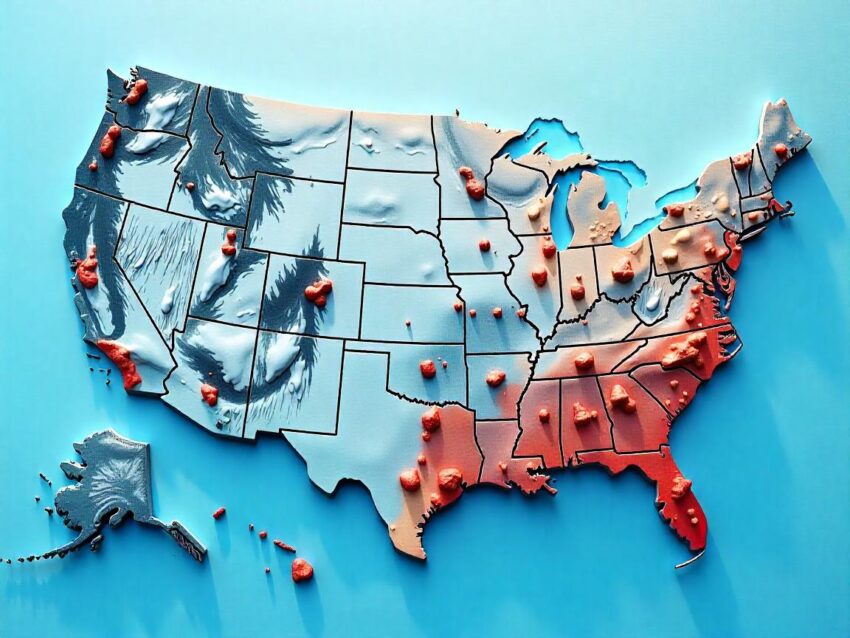Alaska Joins with Juneau, El Paso, Albuquerque, Phoenix, Las Vegas as New Heat Advisory May Batter Travel, Latest Update You Need To Know
Alaska joins with Juneau, El Paso, Albuquerque, Phoenix, Las Vegas as scorching temperatures grip the nation in an unexpected wave. A new heat advisory may cripple travel, and this latest update you need to know could affect thousands of summer plans.
Alaska joins with Juneau, El Paso, Albuquerque, Phoenix, Las Vegas as scorching temperatures grip the nation in an unexpected wave. A new heat advisory may cripple travel, and this latest update you need to know could affect thousands of summer plans. From the icy edges of Alaska to the arid heat of Las Vegas, conditions are shifting fast—and dangerously.
Juneau, El Paso, Albuquerque, Phoenix, and Las Vegas are no strangers to heat, but Alaska joining this list is what has experts alarmed. Travelers are already reporting delays, discomfort, and unexpected closures as these cities battle rising mercury and overloaded infrastructure.
The latest update you need to know? Heat advisories are no longer regional; they’re national. The impact on air travel, hotel operations, and outdoor tourism could be massive. With heat building and warnings expanding, the question isn’t just where to go—it’s whether you should go at all. Read on.
Scorching Heat Advisories Grip US Cities from Alaska to the Southwest, Disrupting Summer Travel Plans
In a climate twist that’s catching travelers off guard, Fairbanks and Juneau in Alaska have joined desert hotspots like Phoenix, Las Vegas, El Paso, and Albuquerque under active heat advisories this June 2025. For many, the biggest surprise isn’t the triple-digit temperatures in the Southwest—it’s that Alaska has issued its first-ever heat advisory, with Fairbanks soaring to nearly 89°F, a rare event for the usually mild interior.
Meanwhile, Juneau’s early-June advisory marked a growing concern in regions unprepared for high heat. Down south, El Paso and Albuquerque are baking under 100+°F forecasts, prompting urgent public safety alerts and travel disruptions. Popular summer destinations like Phoenix and Las Vegas have ramped up emergency measures as temperatures climb beyond 110°F.
For the travel industry, these conditions are causing ripple effects. Airlines are adjusting flight schedules. Hotels are preparing emergency cooling strategies. Outdoor tours and events are being rescheduled or canceled altogether.
With heat advisories spanning such diverse cities—Fairbanks, Juneau, El Paso, Albuquerque, Phoenix, and Las Vegas—this isn’t just a regional issue anymore. Travelers are urged to stay informed, hydrate frequently, and rethink outdoor plans during peak hours. Whether you’re headed to Alaska’s wilderness or the neon glow of the desert, the weather could become your most unexpected challenge.

Alaska Breaks New Ground with First Heat Advisory, Upending Travel Expectations Across the State
Alaska, long known for its glaciers and frosty charm, is now entering unfamiliar territory—heat advisories. For the first time in the state’s recorded history, the National Weather Service has issued an official heat warning for parts of Alaska, with Fairbanks expected to cross 85°F (29°C) this weekend. Though such temperatures might seem mild elsewhere, in Alaska, they’ve triggered a flurry of public health alerts, travel warnings, and concerns for tourists unfamiliar with the interior’s climate quirks.
This isn’t the first time Fairbanks has hit high temperatures. But it is the first time federal weather officials are using formal terminology—”heat advisory” instead of “special weather statement”—to alert the public. And the change is more than semantics. It’s a signal of growing urgency.
Why This Advisory Matters to the Travel and Tourism Industry
Tourism in Alaska thrives on its “cool” reputation. Summer travelers often expect refreshing breezes, scenic hikes, and wildlife sightings—not intense heat. But with Fairbanks now bracing for temperatures more common in Arizona, travel plans are shifting.
Tourists expecting glacier cruises and crisp mornings are instead encountering warm, stuffy lodging without air conditioning. Most buildings in Alaska, including hotels and lodges, are built to retain heat, not release it. Air conditioning is rare, and ventilation systems are limited. As a result, the warm-up could create uncomfortable, even dangerous indoor conditions, especially for elderly tourists or those with health concerns.
Travel Agencies Adjust Plans, Issue New Alerts
Travel agents and tour operators are reacting quickly. Many are issuing updated travel advisories, recommending that visitors pack for heat and stay hydrated. Some are shifting afternoon tours to early mornings or evenings. Hiking guides are avoiding sun-exposed trails in the hottest parts of the day.
Meanwhile, cruise lines that stop in Alaskan ports are now reviewing local shore excursion conditions and updating passengers in real time. Airport authorities in Fairbanks are also ramping up communications to handle increased passenger questions around heat-related safety during layovers or extended delays.

Local Hotels and Lodging Providers Feel the Strain
For hotels, the shift is a wake-up call. In Fairbanks, most hotels still lack air conditioning, relying instead on naturally cool nighttime air to regulate indoor temperatures. But that only works if guests can open their windows. Unfortunately, wildfire smoke, another growing concern, often forces windows to remain shut—trapping heat inside.
This dual challenge of rising heat and fire-related air quality is now forcing some hotels to scramble for portable cooling solutions or emergency fans. With peak summer bookings already in place, cancellations or negative guest experiences could quickly impact reputation and revenue.
Tourism Boards Walk a Tightrope Between Safety and Perception
Alaska’s tourism industry walks a fine line: highlighting the adventure of the north without downplaying real risks. Now, they must help visitors prepare for an Alaska that’s changing fast. Tourism boards are working closely with meteorologists and travel partners to spread awareness.
They’re also considering adjustments to future marketing language—less about “Arctic escape” and more about seasonal variability. Balancing traveler expectations with climate realities is now a year-round concern.
The Wildfire Threat Looms Larger Than Ever
Adding to the challenge is Alaska’s growing wildfire season. When temperatures soar, fire risk climbs. Fairbanks has already experienced three consecutive years of over 100 hours of visibility-reducing smoke—a trend that was almost unheard of just decades ago. Smoke not only ruins the scenic views travelers seek but also closes trails, limits outdoor activities, and adds respiratory risks.
When heat and smoke collide, Alaska’s tourism image is threatened on multiple fronts. That’s why travel planners are urgently reviewing evacuation routes, smoke-free zones, and alternative indoor activities that can be safely recommended to guests.
Airlines, Parks, and Local Services Adjust in Real Time
Airlines flying into Fairbanks International Airport are now coordinating with ground crews to ensure hydration stations and shaded waiting areas are available for travelers affected by any delays. Park rangers in Denali National Park and surrounding wilderness zones are reviewing trail safety protocols, issuing updated heat warnings, and restricting access during the hottest hours.
Travelers heading toward Alaska’s interior are being encouraged to monitor NOAA’s updates and prepare for flexible itineraries. Mobile alerts, temperature monitoring, and weather-based travel apps are being promoted by local tourism groups as must-have resources for all incoming guests.
This Isn’t Climate Panic—It’s Policy Evolution
Though many might assume this heat advisory reflects alarming climate shifts, officials are clear: the temperatures themselves aren’t unprecedented. Fairbanks has reached 90°F before. What’s new is the decision to formally name the risk.
This administrative change—from vague “special weather statements” to official advisories—is meant to better communicate severity. For locals and travelers alike, it adds clarity, urgency, and a new level of preparedness to the summer forecast.
Conclusion: A New Era for Alaska Tourism Begins
Alaska, for the first time ever, is warning visitors to brace for heat—not frost. And while this doesn’t signal the end of glacier getaways or Arctic escapes, it does demand a mindset shift. Travel in Alaska is changing. The first-ever heat advisory is more than just a meteorological update—it’s a message to the world that even the coldest corners of the Earth are feeling the heat.
For tourism leaders, travelers, and communities alike, the takeaway is clear: pack sunblock, hydrate often, and be ready for an Alaska you didn’t expect—but one that still has so much to offer.
The post Alaska Joins with Juneau, El Paso, Albuquerque, Phoenix, Las Vegas as New Heat Advisory May Batter Travel, Latest Update You Need To Know appeared first on Travel and Tour World


